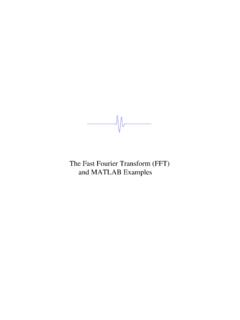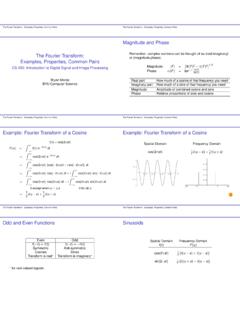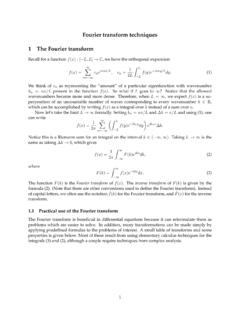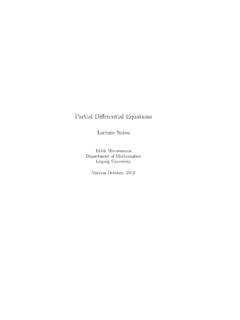Transcription of Manual for Code VISCO-PLASTIC SELF-CONSISTENT (VPSC)
1 I Manual for Code VISCO PLASTIC SELF CONSISTENT (VPSC) Version 7c (last updated: November 13, 2009) Tom (Los Alamos National Laboratory & USA) and Lebensohn (Los Alamos National Laboratory & USA) II INDEX Copyright / Disclosure .. 1 General Description / Recommendation .. 2 What s new in 3 SECTION 1: Theory and Models 1&1 Introduction .. 4 1&2 Kinematics .. 4 1&3 Updating crystal orientation and grain shape .. 6 1&3&1 Crystallographic & morphologic texture rotation 1&3&2 Grain co&rotation 1&5 Self&consistent polycrystal 8 1&5&1 Local behavior and homogenization 1&5&2 Green function and fourier transform 1&5&3 Viscoplastic inclusion and Eshelby tensors 1&5&4 Interaction and localization equations 1&5&5 Self&consistent equations 1&5&6 Algorithm 1&5&7 Secant, affine, tangent and intermediate linearizations 1&6 Hardening of slip and twinning 21 1&6&1 Voce hardening 1&6&2 MTS hardening 1&7 Twinning model .. 26 1&8& Second order formulation.
2 27 1&8&1 Second order moments 1&8&2 Second order procedure 1&8&3 Numerical implementation 1&9 33 IIISECTION 2: Description of VPSC code 2&1 Numerical 35 2&2 Simulation of deformation: Input/Output 36 2&3&1 Grain shape evolution option 2&3&2 Variable velocity gradient option 2&4 Code architecture .. 41 2&5 Units, reference system and conventions .. 42 2&6 Description of Input 44 2&7 Description of Output 55 2&8 Interfacing VPSC with FE codes (VPSC7FE) .. 62 SECTION 3: Examples and applications of VPSC code example 1: Tension and Compression of FCC .. 66 example 2: Rolling of FCC .. 70 example 3: Rolling of BCC .. 74 example 4: Rolling of a 2&phase FCC+BCC aggregate .. 77 example 5: Torsion of FCC .. 79 example 6: Application of MTS model to rolled aluminum .. 82 example 7: Twinning and anisotropy of HCP zirconium .. 85 example 8: Compression of (orthorhombic) olivine .. 91 example 9: Compression of ice (constant rate and creep).
3 94 example 10: Equal Channel Angular Extrusion of 98 Examples of VPSC7FE .. 100 SECTION 4: Appendices Appendix A: Taylor factor .. 102 Appendix B: Von Mises equivalent stress & strain .. 105 Appendix C: Voce hardening and algorithm .. 107 Appendix D: Crystal rotation and misorientation .. 109 1 Code Visco Plastic Self Consistent (VPSC) Version 7c November 2009 Tom , Los Alamos National Laboratory, USA, Lebensohn, Los Alamos National Laboratory, USA, ======================================== ====================== COPYRIGHT NOTICE Portions of this program were prepared by the Regents of the University of California at Los Alamos National Laboratory (the University) under Contract No. W&7405&ENG&36 with the Department of Energy (DOE). This software can be identified by the code LA&CC&99&72 issued by the Classification Office of Los Alamos National Laboratory. The University has certain rights in the program pursuant to the contract and the program should not be copied or distributed outside your organization.
4 All rights in the program are reserved by the DOE and the University. Neither the Government nor the University makes any warranty, express or implied, or assumes any liability or responsibility for the use of this software. ======================================== ====================== DISCLOSURE We distribute this code free of charge on a personal basis and ask you not to make it available to other users. We would appreciate if you acknowledge its use when reporting your results. These notes contain a description of the theory, the capabilities of the VPSC code, and several examples. The code itself is in a permanent state of change and new options, bug&fixes and changes are incorporated as required by new developments, new applications, or as suggested by interactions with the users. In addition, not every possible combination of running conditions is tested when the code is modified.
5 As a consequence use it at your own risk and let us know if you find bugs or run into trouble while using it. We 2 appreciate comments and suggestions that may improve the interface with the users. We strongly recommend running the benchmark cases included in the examples and make sure that you can reproduce the same results. GENERAL DESCRIPTION VPSC is a computer code written in FORTRAN 77 which simulates the plastic deformation of polycrystalline aggregates. VPSC stands for Visco Plastic Self Consistent and refers to the particular mechanical regime addressed (VP) and to the approach used (SC). VPSC was developed for application to low&symmetry materials (hexagonal, trigonal, orthorhombic, trigonal), although it also performs well on cubic materials. VPSC accounts for full anisotropy in properties and response of the single crystals and the aggregate. It simulates the plastic deformation of aggregates subjected to external strains and stresses.
6 VPSC is based on the physical shear mechanisms of slip and twinning, and accounts for grain interaction effects. In addition to providing the macroscopic stress&strain response, it accounts for hardening, reorientation and shape change of individual grains. As a consequence, it predicts the evolution of hardening and texture associated with plastic forming. The simulation procedure can be applied to deformation of metals, intermetallics and geologic aggregates. RECOMMENDATION The VPSC7 Manual includes a thorough description of the related theory. Most of Section 1 can be skipped if you are only interested in running the code. However, Subsections 1&6 and 1&7, dealing with hardening and twinning models, should be read. In addition, most of Section 2, describing input and output files, should be read. The user is advised to become familiar with the examples in Section 3, because they highlight different capabilities of the code.
7 Reproducing the numerical results of the examples is highly recommended both, to become familiar with the input/output files and procedures, and to make sure that the code was properly installed in the user s computer. When compiling VPSC, always use the double precision option. 3 WHAT IS NEW IN VPSC7 ? By comparison with VPSC6, several features and improvements were added to VPSC7. In general: we have improved and accelerated some of the numerical algorithms, subroutines have been added/modified aiming for more flexibility and modulation in the code, and the structure of the main input file ( ) has changed a bit. The new capabilities of the code are: * We have retained (from VPSC6) the full constraints, secant, tangent and neff=10 linearization procedures that control grain&matrix interaction. * We have implemented a new affine linearization procedure which allows the user to run simulations where different deformation modes may have different rate sensitivities (parameter NRS).
8 This more rigorous feature replaces the rather empirical approach to this problem implemented in VPSC6. * We have implemented a new second order linearization procedure based on calculating and using intragranular stress fluctuations for describing the grain response. This procedure is onerous in computing time but is more appropriate for simulation of systems with large variations in stiffness between grains (either directional variations because of anisotropy, or grain&to&grain variations associated with multi&phase systems). * We have retained (from VPSC6) the capability to impose mixed stress and strain&rate boundary conditions, and we have added the possibility of enforcing a stress component as test control. This feature allows for simulations of creep tests. * A new type of process was added. When ivgvar=4 the code rotates rigidly the crystallographic and morphologic texture of the aggregate without imposing deformation.
9 4 SECTION 1: THEORY AND MODELS 1 1 INTRODUCTION During plastic forming the contribution to deformation from elasticity is negligibly small (typically 10&3) by comparison to the plastic component (typically >10&1). In addition, once the elasto&plastic transition is over, the evolution of stress in the grains is controlled by plastic relaxation (slip activity). This means that the size and evolution of the single crystal yield surface controls the stress in the grain. As a consequence, in our formulation we disregard elasticity and describe only plastic contribution to deformation. 1 2 KINEMATICS In this Section we provide a brief overview of the equations used in kinematics. They apply to any continuum plastic body and, in particular, to crystallographic grains and to aggregates. The reader is referred to the book of Gurtin (1981) for a comprehensive treatise on kinematics. We define: X : initial coordinates of a point in the undeformed crystal x(X) : final coordinates of a point in the deformed crystal u=x X : displacement of the point The deformation in the grain is characterized by the displacement gradient tensor Lc and the deformation gradient tensor Fc , defined as: jcicijxuL = (2&1) jicijXxF = (2&2) With the property: iijjxF X= (2&3) Using the definitions of the different tensors it can be shown that: cccF:LF= (2&4) 5 In addition, since plastic deformation is accommodated by shear, and since shear preserves the orientation of the crystal, it is useful to utilize what is called the polar decomposition of the deformation gradient.
10 Such procedure amounts to treat displacements as two sequential steps: a plastic stretch coF which distorts the crystal without reorienting it, followed by a rigid crystal rotation cR that transforms from initial to final crystal axes: (2&5) In crystal axes the stretch obeys a relation like (2&4): cococoFLF= (2&6) where jcicoXuLij = (2&7) is the velocity gradient in the reference frame attached to the crystal axes, given by the linear superposition of shear rates on all active slip and twinning systems: sjsissconbLij = (2&8) The vectors n and b remain invariant in crystal axes. Decomposing the dyadic ssnb into the symmetric and skew symmetric components: ()()sisjsjsi21sijsisjsjsi21sijnbnbqnbnbm =+= (2&9) allows us to decompose the velocity gradient into a strain rate and a rotation rate (spin): cococoijijijWDL+= (2&10a) where =ssijscomDij (2&10b) =ssijscoqWij (2&10c) 6 Replacing (2&5) in (2&3) and using (2&6): ()Tcc0cTccTc1c0c0cc0c1cc0cRLRRRRFFRFRFFL += +== (2&11) Which can be decomposed, using (2&10), into a strain rate and a rotation rate: cijcijcijWDL+= (2&12) where +=+===TccR,coTccTccoccR,coTccoccRRWRRRWR WDRDRD (2&13) The distortion rate Dc is simply a transformation from crystal into current frame, but the rotation rate Wc contains an extra contribution.



